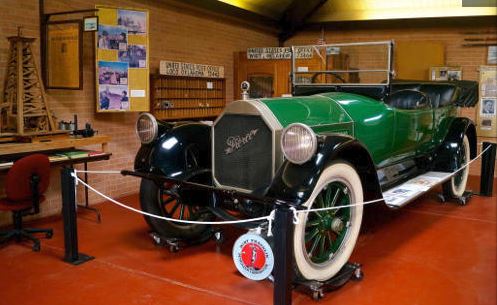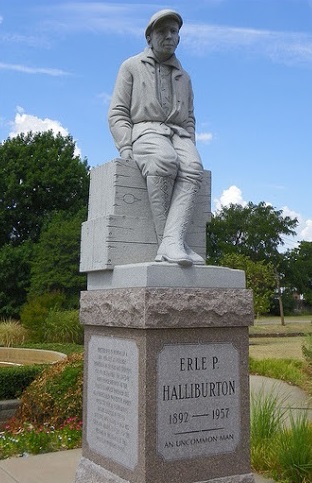by Bruce Wells | Nov 4, 2024 | Petroleum in War
Secret WWII project sent Oklahoma drillers to British oilfield, adding one million barrels of oil production by 1944.
As the United Kingdom fought for its survival during World War II, a team of American oil drillers, derrickhands, roustabouts, and motormen secretly boarded the converted troopship HMS Queen Elizabeth in March 1943. Once their story was revealed years later, they would become known as the Roughnecks of Sherwood Forest.

The 42 volunteers from Noble Drilling and Fain-Porter Drilling companies taken before they secretly embarked for the United Kingdom on March 12, 1943, aboard HMS Queen Elizabeth, which had been converted into a troop transport ship. Photo courtesy of the Guy Woodward Collection, American Heritage Center, University of Wyoming.
By the summer of 1942, the situation was desperate. The future of Great Britain — and the outcome of World War II — depended on the supply of petroleum. At the end of that year, demand for 100-octane fuel had grown to more than 150,000 barrels every day — and German U-boats ruled the Atlantic.
British Secretary of Petroleum, Geoffrey Lloyd in August 1942 called for an emergency meeting of his country’s Oil Control Board to assess the “impending crisis in oil.” (more…)
by Bruce Wells | May 25, 2024 | Petroleum Pioneers
Shallow Oklahoma oilfield launched many petroleum giants.
When an Oklahoma drilling boom arrived in 1919 thanks to shallow wells in the Healdton oilfield, a 27-year-oid inventor applied his new method for cementing oil wells. His service company would become one of the largest in the world.
Erle Palmer Halliburton (1892-1957) received a U.S. patent for his “Method and Means for Cementing an Oil Well in 1921 during Oklahoma drilling booms in and around the Healdton oilfield. He had arrived in Duncan after working for service companies in North Texas towns, including boom town Burkburnett.

The Healdton Oil Museum includes IPAA founder Wirt Franklin’s Pierce-Arrow. The museum hosts annual oil history events.
Halliburton’s New Method Oil Well Cementing Company would receive many patents on its way to becoming Halliburton Corporation, which in 2022 employed 42,000 worldwide specializing in “locating hydrocarbons and managing geological data, to drilling and formation evaluation, well construction and completion, and optimizing production through the life of the field.”
The Healdton field was first revealed in August 1913 by the Wirt Franklin No. 1 well about 20 miles northwest of Ardmore. The wildcat well discovered what soon became known as the “poor man’s field,” because of its shallow depth and low cost of drilling.

The Carter County oilfield, about 70 miles east of Burkburnett, quickly attracted independent producers with limited financial backing — often edging out major oil company competitors.
“Within a 22-mile swath across Carter County, one of the nation’s greatest oil discoveries was made — the Greater Healdton-Hewitt Field,” reported Kenny Arthur Franks in his 1989 history of the oilfield.
“Encompassing some of the richest oil-producing land in America, Healdton and Hewitt, discovered in 1913 and 1919 respectively, produced an astounding 320,753,000 barrels of crude by the close of the first half of the 20th century,” Franks explained.

Erle P. Halliburton Halliburton in 1957. Photo courtesy Oklahoma Hall of Fame.
In addition to launching Halliburton’s petroleum career, the shallow field also helped independent producer Wirt Franklin in 1929 become the first president of the then Tulsa-based Independent Petroleum Association of America (IPAA).
The Healdton Oil Museum preserves Franklin’s and other independent producers’ exploration heritage — and many who got their start in the Healdton field. Among them were former Oklahoma Governor Charles Haskell and Roy Johnson, president of the Healdton Petroleum Company.
According to the Oklahoma Historical Society (OHS), the towns of Wilson, Ringling, and New Healdton (now Healdton) came into existence during the oilfield’s development. Just a few who began their careers there were Robert Hefner Sr. and Lloyd Noble.

“Hefner, a lawyer, introduced the concept of subsurface leasing into mineral rights law,” OHS notes. “Noble developed an international oil business and established the Samuel Roberts Noble Foundation, a nonprofit biotechnology research foundation that helps farmers.”
Born in Ardmore in 1896, Noble found early success at Healdton — and at the Seminole oil boom in 1926.
Noble also was instrumental in the success of a top-secret drilling project during World War II (see Roughnecks of Sherwood Forest).
Cement Well Control
Healdton drilling boom and its many shallow wells, Halliburton established his New Method Oil Well Cementing in Duncan. He was soon experimenting with technologies to improve oil well production. Water intrusion hampered many wells, requiring time and expense for pumping out.
Halliburton noted in his 1920 patent application, “Water has caused the abandonment of many wells which would have developed a profitable output.”
The oilfield cementing innovation — at first resisted by some skeptics — isolated the various down-hole zones, guarded against collapse of the casing and permitted control of the well throughout its producing life.

The city of Duncan, Oklahoma, dedicated a Halliburton statue in 1993.
According to William Pike, former editor-in-chief of E&P magazine, Halliburton’s well cementing process revolutionized how oil and natural gas wells were completed.
Halliburton also patented other modern cementing technologies, including the jet mixer, the remixer and the float collar, guide shoe and plug system, bulk cementing, multiple-stage cementing, advanced pump technology and offshore cementing technology.

Halliburton’s only real service company competitor for decades was Carl Baker of Baker Oil Tools. Halliburton Oil Well Cementing Company in 1938 expanded into offshore work with a barge-mounted unit cementing a well off the Louisiana coast.
Meanwhile, another Oklahoma oilfield service company, the Reda Pump Company, had been founded by Armais Arutunoff, thanks to help from his close friend Frank Phllips and Phillips Petroleum of Bartlesville, Oklahoma.
Arutunoff invented a practical electric submersible pump). As Phillips foresaw, use of the Arutunoff artificial lift pump would dominate U.S. oilfields by 1938 — and oilfields worldwide after World War II.
Hydraulic Fracking
A major petroleum industry milestone came in 1949, when Halliburton and Stanolind Oil Company completed a well near Duncan, Oklahoma – the first commercial application of hydraulic fracturing (see Shooters – A “Fracking” History).
“Halliburton was ever the tinkerer. He owned nearly 50 patents,” noted Pike. “Most are oilfield, and specifically cementing related, but the number includes patents for an airplane control, an opposed piston pump, a respirator, an airplane tire and a metallic suitcase.”

Thanks in part to his prospering oilfield service company, Halliburton in 1931 started his own airline in Tulsa, the Southwest Air Fast Express — Safeway Airlines — that later merged with American Airlines.
As U.S. production from oil and natural gas shale formations grew in 2018, Halliburton Corporation’s worldwide operations employed 80,000 people.
Learn more about Halliburton’s oilfield inventiveness in Halliburton cements Wells.
_______________________
Recommended Reading: Ragtown: A History of the Greater Healdton-Hewitt Oil Field (1989); Erle P. Halliburton: Genius with Cement (1959). Your Amazon purchase benefits the American Oil & Gas Historical Society. As an Amazon Associate, AOGHS earns a commission from qualifying purchases.
(1959). Your Amazon purchase benefits the American Oil & Gas Historical Society. As an Amazon Associate, AOGHS earns a commission from qualifying purchases.
_______________________
The American Oil & Gas Historical Society (AOGHS) preserves U.S. petroleum history. Please become an AOGHS supporter and help maintain this energy education website and expand historical research. For more information, contact bawells@aoghs.org. © 2024 Bruce A. Wells.
Citation Information – Article Title: “Halliburton and the Healdton Oilfield.” Authors: B.A. Wells and K.L. Wells. Website Name: American Oil & Gas Historical Society. URL: https://aoghs.org/petroleum-pioneers/halliburton-and-healdton-oilfield. Last Updated: June 3, 2024. Original Published Date: July 14, 2015.







